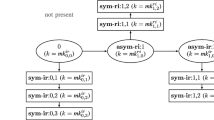Abstract
We consider authentication/secrecy schemes from the information theoretic approach. We extend results on unconditionally secure authentication schemes and then consider unconditionally secure authentication schemes that offer perfect L-fold secrecy. We consider both ordered and unordered secrecy. We establish entropy bounds on the encoding rules for authentication schemes with these types of secrecy. We provide some combinatorial characterizations and constructions for authentication schemes having perfect L-fold secrecy that meet these bounds.
Similar content being viewed by others
References
M. De Soete, Some constructions for authentication-secrecy codes, Advances in Cryptology-EUROCRYPT' 88, Lecture Notes in Comput. Sci., Vol. 330 (1988) pp. 57-75.
E. F. Brickell, A few results in message authentication, Congressus Numerantium, Vol. 43 (1984) pp. 141-154.
V. Fåk, Repeated use of codes which detect deception, IEEE Trans. on Inf. Theory, Vol. 25 (1979) pp. 233-234.
E. Gilbert, F. J. MacWilliams and N. J. A. Sloane, Codes which detect deception, Bell Systems Tech. J., Vol. 53 (1974) pp. 405-424.
P. Godlewski and C. Mitchell, Key-minimal cryptosystems for unconditional secrecy, J. Cryptology, Vol. 3 (1990) pp. 1-25.
J. L. Massey, Cryptography-a selective survey, Digital Communications, North-Holland (1986) pp. 3-21.
C. Mitchell, M. Walker and P. Wild, The combinatorics of perfect authentication schemes, SIAM J. Disc. Math., Vol. 7 (1994) pp. 102-107.
D. Pei, Information-theoretic bounds for authentication codes and block designs, J. Cryptology, Vol. 8 (1995) pp. 177-188.
D. Pei and Y. Wang, Authentication codes achieving information-theoretic bounds, preprint.
U. Rosenbaum, A lower bound on authentication after having observed a sequence of messages, J. Cryptology, Vol. 6 (1993) pp. 135-156.
R. Safavi-Naini and L. Tombak, Authentication codes in plaintext and chosen-content attacks, Advances in Cryptology-EUROCRYPT' 94, Lecture Notes in Comput. Sci., Vol. 950 (1995) pp. 254-265.
P. Schobi, Perfect authentication systems for data with arbitrary statistics. Presented at EUROCRYPT' 86.
C. E. Shannon, Communication theory of secrecy systems, Bell System Tech. Journal, Vol. 28 (1949) pp. 656-715.
G. J. Simmons, A game theory model of digital message authentication, Congressus Numerantium, Vol. 34 (1982) pp. 413-424.
G. J. Simmons, Authentication theory/coding theory, Advances in Cryptology-CRYPTO' 84, Lecture Notes in Comput. Sci., Vol. 196 (1984) pp. 411-431.
B. Smeets, A short proof of a lower bound on the probability of deception in multiple authentication, J. Cryptology, submitted.
D. R. Stinson, The combinatorics of authentication and secrecy codes, J. Cryptology,Vol. 2 (1990) pp. 23-49.
D. R. Stinson and L. Teirlinck, A construction for authentication/secrecy codes from 3-homogeneous permutation groups, European J. Combin., Vol. 11 (1990) pp. 73-79.
M. Walker, Information-theoretic bounds for authentication schemes, J. Cryptology, Vol. 2 (1990) pp. 131-143.
Author information
Authors and Affiliations
Rights and permissions
About this article
Cite this article
Casse, L.R.A., Martin, K.M. & Wild, P.R. Bounds and Characterizations of Authentication/Secrecy Schemes. Designs, Codes and Cryptography 13, 107–129 (1998). https://doi.org/10.1023/A:1008270111149
Issue Date:
DOI: https://doi.org/10.1023/A:1008270111149




